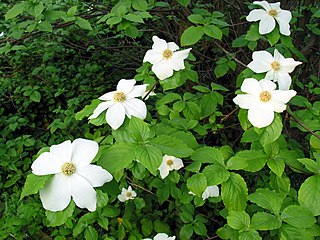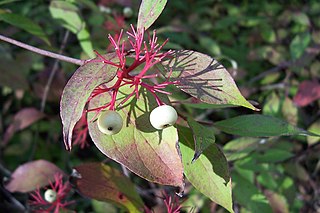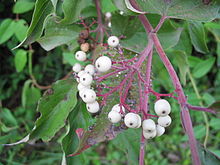
Cornus florida, the flowering dogwood, is a species of flowering tree in the family Cornaceae native to eastern North America and northern Mexico. An endemic population once spanned from southernmost coastal Maine south to northern Florida and west to the Mississippi River. The tree is commonly planted as an ornamental in residential and public areas because of its showy bracts and interesting bark structure.

Cornus is a genus of about 30–60 species of woody plants in the family Cornaceae, commonly known as dogwoods or cornels, which can generally be distinguished by their blossoms, berries, and distinctive bark. Most are deciduous trees or shrubs, but a few species are nearly herbaceous perennial subshrubs, and some species are evergreen. Several species have small heads of inconspicuous flowers surrounded by an involucre of large, typically white petal-like bracts, while others have more open clusters of petal-bearing flowers. The various species of dogwood are native throughout much of temperate and boreal Eurasia and North America, with China, Japan, and the southeastern United States being particularly rich in native species.

Arctostaphylos uva-ursi is a plant species of the genus Arctostaphylos widely distributed across circumboreal regions of the subarctic Northern Hemisphere. Kinnikinnick is a common name in Canada and the United States. Growing up to 30 centimetres in height, the leaves are evergreen. The flowers are white to pink and the fruit is a red berry.

Cornus kousa is a small deciduous tree 8–12 m (26–39 ft) tall, in the flowering plant family Cornaceae. Common names include kousa, kousa dogwood, Chinese dogwood, Korean dogwood, and Japanese dogwood. Synonyms are Benthamia kousa and Cynoxylon kousa. It is a plant native to East Asia including Korea, China and Japan. Widely cultivated as an ornamental, it is naturalized in New York State.

Cornus nuttallii, the Pacific dogwood,western dogwood, or mountain dogwood, is a species of dogwood tree native to western North America. The tree's name used by Hul'q'umi'num'-speaking nations is Kwi’txulhp.

Cornus canadensis is a species of flowering plant in the dogwood family Cornaceae, native to eastern Asia and North America. Common names include Canadian dwarf cornel, Canadian bunchberry, quatre-temps, crackerberry, and creeping dogwood. Unlike its relatives, which are for the most part substantial trees and shrubs, C. canadensis is a creeping, rhizomatous perennial growing to about 20 centimetres tall.

Cornus sericea, the red osier or red-osier dogwood, is a species of flowering plant in the family Cornaceae, native to much of North America. It has sometimes been considered a synonym of the Asian species Cornus alba. Other names include red brush, red willow, redstem dogwood, redtwig dogwood, red-rood, American dogwood, creek dogwood, and western dogwood.

Rhododendron groenlandicum is a flowering shrub with white flowers and evergreen leaves that is used to make a herbal tea.

Cornus alternifolia is a species of flowering plant in the dogwood family Cornaceae, native to eastern North America, from Newfoundland west to southern Manitoba and Minnesota, and south to northern Florida and Mississippi. It is rare in the southern United States. It is commonly known as green osier, alternate-leaved dogwood, and pagoda dogwood.

Quercus lyrata, the overcup oak, is an oak in the white oak group. The common name, overcup oak, refers to its acorns that are mostly enclosed within the acorn cup. It is native to lowland wetlands in the eastern and south-central United States, in all the coastal states from New Jersey to Texas, inland as far as Oklahoma, Missouri, and Illinois. There are historical reports of it growing in Iowa, but the species appears to have been extirpated there. It is a slow-growing tree that often takes 25 to 30 years to mature. It has an estimated lifespan of 400 years.

Cornus suecica, the dwarf cornel or bunchberry, is a species of flowering plant in the dogwood family Cornaceae, native to cool temperate and subarctic regions of Europe Asia, and North America.

Oenothera lindheimeri, commonly known as Lindheimer's beeblossom, white gaura, pink gaura, Lindheimer's clockweed, and Indian feather, is a species of Oenothera. Several of its common names derive from the genus Gaura, in which this species was formerly placed.

Cornus amomum, the silky dogwood, is a species of dogwood native to the southern Ontario and eastern United States, from Michigan and Vermont south to Alabama and Florida. Other names include red willow, silky cornel, kinnikinnick, and squawbush.

Sambucus racemosa is a species of elderberry known by the common names red elderberry and red-berried elder.

Gaylussacia dumosa is a species of flowering plant in the heath family known by the common names dwarf huckleberry, bush huckleberry, and gopherberry. It is native to eastern North America from Newfoundland to Louisiana and Florida. It occurs along the coastal plain and in the mountains.

Cornus controversa, syn. Swida controversa, is a species of flowering plant in the genus Cornus of the dogwood family Cornaceae, native to China, Korea, the Himalayas and Japan. It is a deciduous tree growing to 50 ft (15 m), with multiple tiered branches. Flat panicles of white flowers appear in summer, followed by globose black fruit. Ovate dark green leaves are glaucous underneath and turn red-purple in autumn. It is cultivated in gardens and parks in temperate regions.

Cornus × unalaschkensis is a species of flowering plant in the Cornaceae, the dogwood family. Common names for the plant include Alaskan bunchberry, western cordilleran bunchberry, or simply western bunchberry.

Cornus rugosa, commonly called roundleaf dogwood or round-leaved dogwood, is a deciduous tree native to northern parts of the eastern and central United States and southern parts of central and eastern Canada.
Cornus × arnoldiana, the Arnold dogwood, is a hybrid dogwood native to eastern North America. It is reported from Ontario, Missouri, Ohio, Pennsylvania, and Massachusetts. It is a member of the dogwood genus Cornus and the family Cornaceae.

Cornus obliqua, the blue-fruited dogwood, silky dogwood, or pale dogwood, is a flowering shrub of eastern North America in the dogwood family, Cornaceae. It is sometimes considered a subspecies of Cornus amomum, which is also known as silky dogwood. It was first described in 1820 by Constantine Samuel Rafinesque. It is in the subgenus Kraniopsis.





















